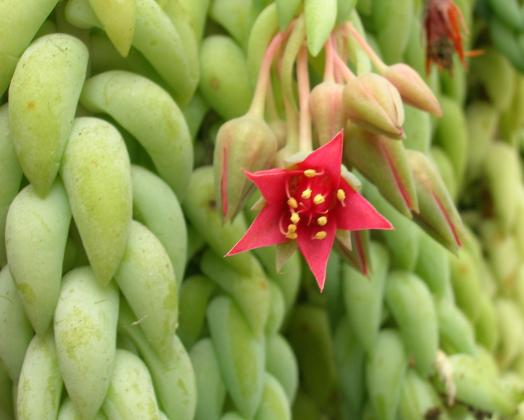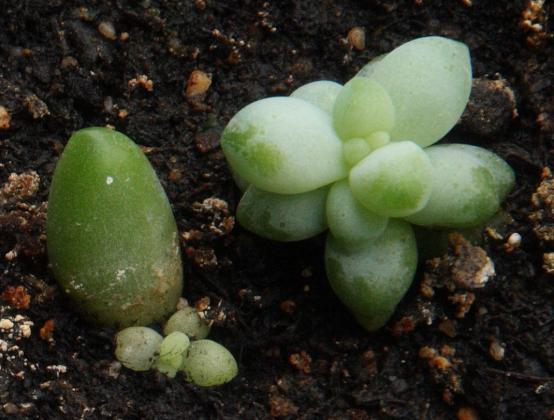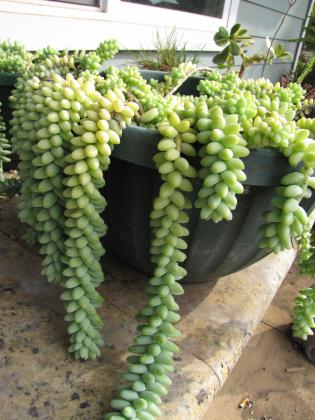Sedum morganianum –2000 feet up a rocky cliff
Backyard Horticulture
Sedum morganianum, donkey’s tail or donkey tail, is a flowering evergreen leaf succulent. This means it has a thick skin that holds water. But, it is not a cactus. Its blue-green to gray-green leaves are bulb-like, sometimes banana-shaped. The leaves come to a point and are about .5 inches long. They are on a stem about 2-feet long, usually hanging in a pot. The small showy flowers are dark pink to red.
There is a similar species, S. burrito, that is slightly smaller with leaves more rounded at the end. It’s hard to tell the difference, so I do what the nursery industry and most people do and just call them both S. morganianum, donkey’s tail. In Mexico where it’s native, it is called burro’s tail or cola de burro. It is in the Crassulaceae, stonecrop, family which evolved in Africa about 100 million years ago.
While most agree that the word sedum is from Greek, some said it means “sit” for its ability to perch or sit on rocks and buildings. Some said it means “live forever” because it’s easily propagated. Still others claimed the name sedum comes from the Latin word sedar, which means “to calm,” because in the ancient world some sedums were used as medicine.
There are several very technical articles researching S. morganianum at the National Institutes of Health, ncbi.nlm.nih.gov. One study about it and other plants said, “Serotonin (5-hydroxytryptamine; SER) ... is a physiologically active amine which is a well-known neurotransmitter that regulates mood, sleep and anxiety in mammals... This review focuses on the phytoserotonin and its occurrence, localization, quantities, biosynthesis, functions as well as its beneficial effects as dietary SER to humans.” The title is “Phytoserotonin.” Note that handling the plant may irritate the skin of some people. S. morganianum is in the Food and Drug Administration Poison Plant Database at fda.gov.
This plant was a mystery to the world of modern botany when it was first found in Veracruz, Mexico, in 1935 by Eric Walther, a botanist from San Francisco. He saw the plant for sale in a Veracruz nursery. There were many planted in metal cans hanging from the wall. He later saw the plant for sale in other shops, in homes and planted on some roofs. Around the world, for millennia, certain plants have been grown on roofs as a protection from lightning.
The International Crassulaceae Network, crassulaceae.ch, in their article “The Sedum morganianum habitat discovered” picked up Walther’s story. “He purchased several of the unknown plants... Walther was unable to find any information about the plant s natural habitat or its flowering characteristics. Indeed, he had no idea to which genus it belonged. Some three years later, Dr. Meredith Morgan Sr., a hobbyist and expert grower from Richmond, California, flowered the plants in his garden. It had pink flowers that appear from the tips of the long branches. This enabled Walther to complete a description of the new species, which he named Sedum morganianum in honour of Dr. Morgan.” It’s said that 1938 was the first time the plant had flowered outside of Mexico. It was officially introduced to the world when it appeared in the September 1938, Vol. 10, No. 3, of the Cactus and Succulent Society of America Journal.
By the 1950s, it was being grown throughout the U.S., Europe and Australia. But, no one in the botany community had ever seen the plant in its natural habitat so a mystery still remained. In the literature it was listed as “Sedum morganianum Walther, Distribution: unknown, Type locality: unknown, the type being a cultivated plant of unknown origin in the wild.”
The mystery was solved decades later with botanists in Sochiapa, a city in the Mexican state of Veracruz. The story continued, “In February 2008, David Jimeno and Amparo Alvalat were doing a floristic study at Bellreguard Ranch. As they approached the rim of a canyon, Carlos Ros, the owner of this deer-hunting place, told them that a rare plant grew here on his 1200-acre property and pointed out the Burro’s Tail on the huge cliffs... In a visual inspection Carlos Ros has noted that the Burro’s Tail grows only in an altitudinal range of 600 to 700m along the cliffs of the two ravines in which it occurs.” The ravines are Mayatla and Ixcacotitla. S. morganianum was growing more than 2000 feet up the side of a vertical rocky cliff.
It may seem odd that a plant could be so common in pots and yet not be seen growing in the wild. The answer, other than it being physically difficult to see or reach, is that once you have the plant it is very easy to propagate. Each leaf that touches dirt will root and start a new plant. Often the slightest movement will dislodge one of the leaves. So while it is difficult to successfully transplant an entire plant, it’s easy to start new ones.
Both S. morganianum and S. burrito have been awarded the Royal Horticultural Society, rhs.org.uk, Award of Garden Merit.
Deborah Richardson is a freelance reporter for The Examiner with a fondness for flora in its natural setting.



